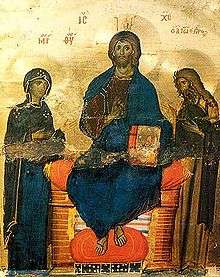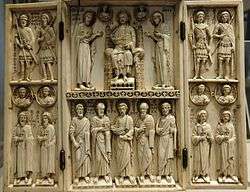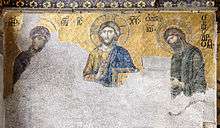Deesis

In Byzantine art, and later Eastern Orthodox art generally, the Deësis or Deisis (Greek: δέησις, "prayer" or "supplication"), is a traditional iconic representation of Christ in Majesty or Christ Pantocrator: enthroned, carrying a book, and flanked by the Virgin Mary and St. John the Baptist, and sometimes other saints and angels. Mary and John, and any other figures, are shown facing towards Christ with their hands raised in supplication on behalf of humanity.
In early examples, it was often placed on the templon beam in Orthodox churches or above doors, though it also appears on icons and devotional ivories.
After the development of the full iconostasis screen there was room for a larger "Deesis row" or "Great Deesis" of full-length figures, and the number of figures expanded, in both Byzantium and Russia. Usually this row is above the level of the doors, and below the row depicting the Twelve Great Feasts, sometimes the Deesis is above the Feasts. The central Christ is therefore above the main door in the screen. Soon seven figures, usually one to a panel, were standard, in order of proximity to Christ in the centre: on the left (Christ's right) Mary, the Archangel Michael and Saint Peter, and on the right John the Baptist, the Archangel Gabriel and Saint Paul. Especially in Russian examples, a number of saints of local significance are often included behind these, as space allows. Andrey Rublev's row for the Cathedral of the Dormition in Vladimir were 3.14 metres (over ten feet) high. [1] In the Greek tradition the Apostles are more likely to occupy extra panels.
The presence of Mary and John, and other figures, is one of the differences with the Western Christ in Majesty, where the Four Evangelists and/or their symbols are more commonly included around Christ. The Deesis composition is also commonly found in the West, especially those parts of Italy under Byzantine influence, but also the rest of Europe. It often forms part of a scene of the Last Judgement. The use of the image declined slowly throughout the Middle Ages, and it is never as common as the Western forms of Christ in Majesty.
Gallery
 Harbaville Triptych, middle of the 10th century, ivory, Constantinople, Louvre
Harbaville Triptych, middle of the 10th century, ivory, Constantinople, Louvre Five-panel Deesis row (center), Iconostasis in the Cathedral of the Annunciation in Moscow Kremlin by Theophanes the Greek, 1405 - the first five-row Iconostasis
Five-panel Deesis row (center), Iconostasis in the Cathedral of the Annunciation in Moscow Kremlin by Theophanes the Greek, 1405 - the first five-row Iconostasis A larger Russian deesis row; Uglich Cathedral
A larger Russian deesis row; Uglich Cathedral Mosaic of the Deesis, 13th century, Hagia Sophia
Mosaic of the Deesis, 13th century, Hagia Sophia
References
| Wikimedia Commons has media related to Deesis. |
- ↑ Maria Cheremeteff in Leong, Albert ed.;The Millennium: Christianity and Russia, A.D. 988-1988; p.110-8; 1990; St Vladimir's Seminary Press;ISBN 0-88141-080-2
External links
- Definition of Deesis -- Includes photos of the Deesis in the Hagia Sophia.